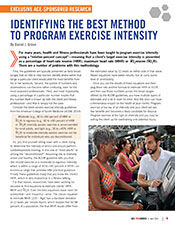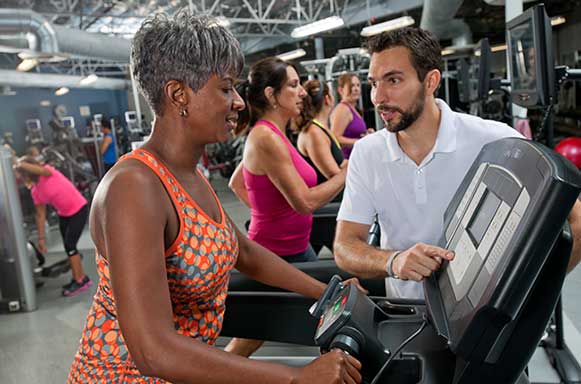
For many years, health and fitness professionals have been taught to program exercise intensity using a “relative-percent concept”—meaning that a client’s target exercise intensity is presented as a percentage of heart-rate reserve (HRR), maximum heart rate (MHR) or VO2reserve (VO2R). There are a number of problems with this methodology. First, the guidelines are typically presented as fairly broad ranges that do little to help trainers identify where within that range a particular client would yield the most benefits from his or her workouts. Second, the jumble of numbers and abbreviations can become rather confusing, even for the most seasoned professionals. Third, and most importantly, using a percentage of a particular number implies that the number itself is known by both the client and fitness professional—and that is simply not the case.
Consider the latest aerobic-exercise intensity guidelines from the American College of Sports Medicine (ACSM, 2014):
Moderate (e.g., 40 to <60 percent of HRR or VO2R) to vigorous (e.g., 60 to <90 percent of HRR or VO2R) intensity aerobic exercise is recommended for most adults, and light (e.g., 30 to <40% HRR or VO2R) to moderate intensity aerobic exercise can be beneficial for individuals who are deconditioned.
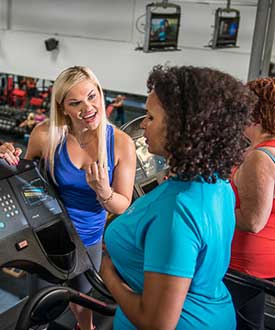
So, you find yourself sitting down with a client trying to determine the intensity at which she should perform cardiorespiratory training. Is she one of “most adults” or among the “deconditioned”? Assuming she is relatively active and healthy, the ACSM guideline tells you that she should exercise at a moderate-to-vigorous intensity, which is within a range of 40 to <90 percent of HRR—an enormous range that provides little practical guidance. Finally, these guidelines imply that you know the client’s HRR, which is very impractical in a fitness setting.
For that reason, researchers have been working for decades to find equations to estimate clients’ HRR, MHR and VO2R. Even the best equations leave room for substantial—and impactful—error. The classic equation to estimate MHR (220 – Age) has a standard deviation of 12 beats per minute (bpm), which implies that for 68 percent of a population, the true MHR would differ from the estimated value by 12 beats on either side of that value. Newer equations have better results, but all carry some level of unreliability.
Once you use the results of these equations and then plug them into another formula to estimate HRR or VO2R, and then use those numbers across the broad ranges offered by the ACSM guidelines, you have multiple layers of estimates and a lot of room for error. And this error can have a tremendous impact on the health of your clients. Program exercise at too low of an intensity and your client will see few benefits and becomes a likely candidate for dropout. Program exercise at too high an intensity and you may be setting the client up for overtraining and potential injury.
Stated simply, being able to accurately and reliably identify the appropriate exercise intensity for an individual client is absolutely essential, and cannot be accomplished using the relative-percent concept. Alternatively, it has been suggested that a “threshold-based model” for establishing exercise intensity might better identify the lowest effective training stimulus for all individuals with varying fitness levels. The ACE Integrated Fitness Training® (ACE IFT®) Model, which was first introduced in 2010 and is featured in the latest ACE Personal Trainer Manual (ACE, 2014), recommends a threshold-based approach to programming exercise intensity (the ACE three-zone training model). However, despite the intuitive merit in support of the threshold-based model, the experimental evidence supporting this approach is lacking.
Therefore, ACE commissioned Lance C. Dalleck, Ph.D., and his team at Western State Colorado University, to conduct a study comparing the effectiveness of two exercise-training programs for improving cardiorespiratory fitness: the ACE three-zone training model versus the more common ACSM-recommended relative-percent method. The research team hypothesized that:
- The ACE three-zone training model would elicit greater mean changes in cardiorespiratory fitness (as measured by VO2max) when compared to the relative-percent method.
- Participants in the ACE three-zone training model group would be more likely to have favorable VO2max responses. Comparatively, participants in the relative-percent method group would be more likely to experience a VO2max nonresponse to exercise training.
The Study
For this study, Dr. Dalleck and his colleagues recruited 42 non-smoking men and women who were sedentary (i.e., participating in less than 30 minutes of moderate-intensity physical activity on at least three days per week for at least three months) and were considered low-to-moderate risk according to the ACSM guidelines. Participants were instructed to maintain their current eating habits and to avoid performing additional exercise beyond what was required for the study.
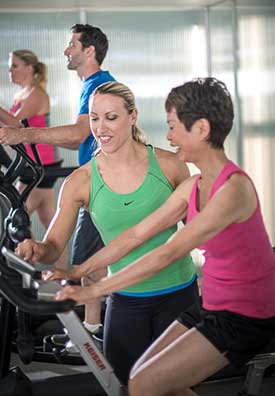
The primary outcome variable—VO2max, which the researchers describe as the fundamental measurement of cardiorespiratory fitness—was measured three times (at the outset, midpoint and conclusion of the study). Secondary outcome variables, including resting heart rate and blood pressure, basic anthropometric measures, and fasting blood lipid and blood glucose measurements, were acquired at the start and finish of the study.
After determining each participant’s HRR and first and second ventilatory thresholds (VT1 and VT2) in the laboratory, the researchers divided the participants into three groups: a non-exercise control group, a group for whom the relative-percent method was used to program exercise according to percentages of HRR, and a group for whom a threshold-based method was used to program exercise according to VT1 and VT2 as recommended in ACE’s three-zone model. For ease of discussion, the two exercise groups are referred to here as the HRR group and the ACE-3ZM group. The 12-week exercise program for each training group is presented in Figure 1. Each group performed a similar frequency and duration of exercise training on a treadmill. Overall, the exercise programs were intended to fulfill the consensus recommendation of 150 minutes per week of moderate-intensity exercise, and the programs were progressed as recommended by both ACE (2014) and ACSM (2014).
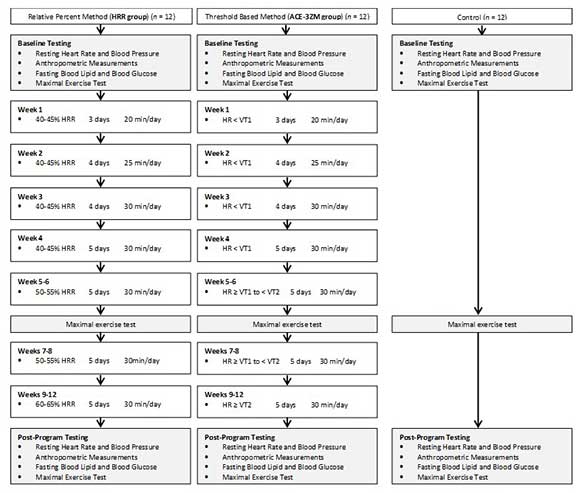
Figure 1. Flow chart of experimental procedures and exercise prescription for each of the two exercise training groups. HR, heart rate; HRR, heart-rate reserve; VT1, first ventilatory threshold; VT2, second ventilatory threshold.
The Results
After the 12-week study was complete, the research team found that VO2max increased in both the HRR (1.76 ± 1.93 mL/kg/min) and ACE-3ZM (3.93 ± 0.96 mL/kg/min) groups as compared to the control group of non-exercisers, but the ACE-3ZM group saw considerably more improvement. (The other variables the researchers measured did not significantly differ at the conclusion of the study.) Significantly, the researchers identified an important interaction between the method used to determine intensity and the change in VO2max values. In the HRR group, only eight of the 12 participants experienced a favorable change in VO2max, while all 12 members of the ACE-3ZM group elicited a positive improvement.
Field Testing
An important difference between the relative-percent concept and the threshold-based concept for exercise programming is that the values needed for the latter can be found using field tests in a fitness setting, as opposed to the laboratory needed to measure VO2max and HRR. This means that not only can the initial program be developed using values the client can actually see being accurately measured, but that follow-up tests can be conducted to provide concrete proof of improved health.
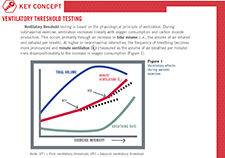
Click here for a PDF
This points to an important question, which was raised by Dr. Dalleck: “Are we appropriately individualizing the intensity for clients when we use the relative-percent method to develop their programs?” The results of this study provide a resounding “no.” Translate this outcome to the real world and you would find that one-third of your clients—clients who are working hard and following the programs you design for them—would not experience a measurable improvement in cardiorespiratory fitness.
Up to 20 percent of exercisers just do not seem to respond to training as expected, says Dr. Dalleck, most likely because a program built around a percentage of an estimated value is sometimes not difficult enough to elicit physiological changes. In other words, the intensity is simply too low to be of value. “Using the threshold-based concept eliminates this possibility because the exerciser is training precisely at his or her metabolic threshold, which greatly increases the likelihood of a positive adaptation in response to training,” says Dr. Dalleck.
These results support both research hypotheses and underscore the importance of establishing exercise intensity relative to threshold measurements. It makes intuitive sense that conducting field tests to determine VT1 and VT2 would allow health and fitness professionals to truly individualize training programs more so than using a relative-percent value derived from estimates, equations and wide ranges of intensity. Stated simply, this study provides the data to support that intuition.
References
American College of Sports Medicine (2014). ACSM’s Guidelines for Exercise Testing and Prescription (9th ed.). Philadelphia: Wolters Kluwer/Lippincott Williams & Wilkins.
American Council on Exercise (2014). ACE Personal Trainer Manual (5th ed.). San Diego: American Council on Exercise.





 by
by 

